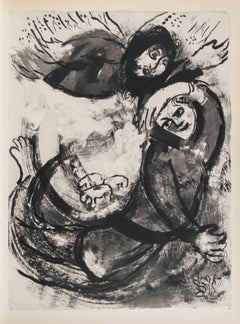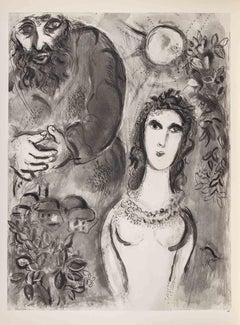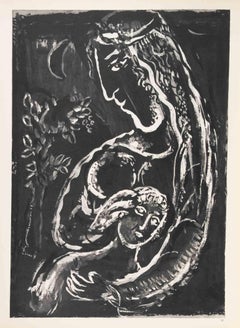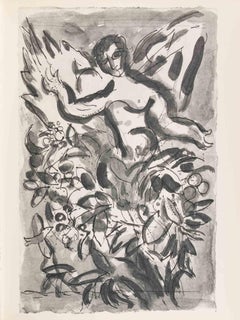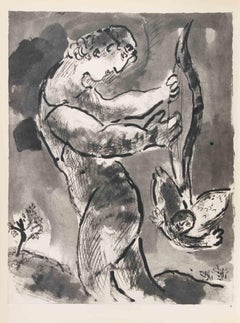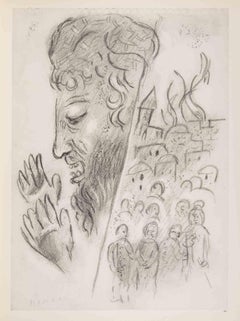1960s Art
to
94
399
92
51
13
2
Overall Width
to
Overall Height
to
2
1,245
3
63
35
18
358
557
93
31
219
149
37
27
5
4
2
1
1
514
41
2
347
274
167
148
144
138
70
30
24
18
12
11
10
9
7
6
6
5
5
5
435
81
81
25
12
8
3,216
551
344
294
88
245
241
189
Period: 1960s
Artist: Marc Chagall
Artist: Frank Roth
Enosch, Guardian of the Celestial Treasure - Héliogravure by Marc Chagall - 1960
By Marc Chagall
Located in Roma, IT
Héliogravure on brown-toned paper, no signature.
Héliogravure on bot sheets, recto and verso.
Edition of 6500 unsigned copies. Printed by Mourlot and published by Tériade on the A...
Category
Surrealist 1960s Art
Materials
Photogravure
The Young Woman and the Old Man - Héliogravure by Marc Chagall - 1960
By Marc Chagall
Located in Roma, IT
Héliogravure on brown-toned paper, no signature.
Héliogravure on bot sheets, recto and verso.
Edition of 6500 unsigned copies. Printed by Mourlot and published by Tériade on the A...
Category
Surrealist 1960s Art
Materials
Photogravure
The Night in the Desert - Héliogravure by Marc Chagall - 1960
By Marc Chagall
Located in Roma, IT
Héliogravure on brown-toned paper, no signature.
Héliogravure on bot sheets, recto and verso.
Edition of 6500 unsigned copies. Printed by Mourlot and published by Tériade on the A...
Category
Surrealist 1960s Art
Materials
Photogravure
The Cherub - Héliogravure by Marc Chagall - 1960
By Marc Chagall
Located in Roma, IT
Héliogravure on brown-toned paper, no signature.
Héliogravure on bot sheets, recto and verso.
Edition of 6500 unsigned copies. Printed by Mourlot and published by Tériade on the A...
Category
Surrealist 1960s Art
Materials
Photogravure
The Flood, The Fish and a Woman - Héliogravure by Marc Chagall - 1960
By Marc Chagall
Located in Roma, IT
Héliogravure on brown-toned paper, no signature.
Héliogravure on bot sheets, recto and verso.
Edition of 6500 unsigned copies. Printed by Mourlot and published by Tériade on the A...
Category
Surrealist 1960s Art
Materials
Photogravure
The Prophet - Héliogravure by Marc Chagall - 1960
By Marc Chagall
Located in Roma, IT
Héliogravure on brown-toned paper, so signature.
On bot sheets, recto and verso.
Edition of 6500 unsigned copies. Printed by Mourlot and published by Tériade, Paris.
Ref. Mourlot,...
Category
Surrealist 1960s Art
Materials
Photogravure
Cain and Abel - Lithograph by Marc Chagall - 1960
By Marc Chagall
Located in Roma, IT
Color lithograph realized by Marc Chagall in 1960 to illustrate "The Bible".
Edition of 6500, published by Tériade in no. 33 and 34 of the Art Magazine Verve.
Printed by Mourlot a...
Category
Surrealist 1960s Art
Materials
Lithograph
The King and his Throne - Héliogravure by Marc Chagall - 1960
By Marc Chagall
Located in Roma, IT
Héliogravure on brown-toned paper, so signature.
On bot sheets, recto and verso.
Edition of 6500 unsigned copies. Printed by Mourlot and published by Tériade, Paris.
Ref. Mourlot,...
Category
Surrealist 1960s Art
Materials
Photogravure
Amon's Pain - Héliogravure by Marc Chagall - 1960
By Marc Chagall
Located in Roma, IT
Héliogravure on brown-toned paper, so signature.
On bot sheets, recto and verso.
Edition of 6500 unsigned copies. Printed by Mourlot and published by Tériade, Paris.
Ref. Mourlot,...
Category
Surrealist 1960s Art
Materials
Photogravure
Assuerus Invited by Esther - Héliogravure by Marc Chagall - 1960
By Marc Chagall
Located in Roma, IT
Héliogravure on brown-toned paper, so signature.
On bot sheets, recto and verso.
Edition of 6500 unsigned copies. Printed by Mourlot and published by Tériade, Paris.
Ref. Mourlot,...
Category
Surrealist 1960s Art
Materials
Photogravure
Sarah and the Angels - Héliogravure by Marc Chagall - 1960
By Marc Chagall
Located in Roma, IT
Héliogravure on brown-toned paper, so signature.
On bot sheets, recto and verso.
Edition of 6500 unsigned copies. Printed by Mourlot and published by Tériade, Paris.
Ref. Mourlot,...
Category
Surrealist 1960s Art
Materials
Photogravure
Rebekah Gives Abraham's Servants Something...-Héliogravure by Marc Chagall-1960
By Marc Chagall
Located in Roma, IT
Héliogravure on brown-toned paper, so signature.
On bot sheets, recto and verso.
Edition of 6500 unsigned copies. Printed by Mourlot and published by Tériade, Paris.
Ref. Mourlot,...
Category
Surrealist 1960s Art
Materials
Photogravure
Two Girls at the Well - Héliogravure by Marc Chagall - 1960
By Marc Chagall
Located in Roma, IT
Héliogravure on brown-toned paper, so signature.
On bot sheets, recto and verso.
Edition of 6500 unsigned copies. Printed by Mourlot and published by Tériade, Paris.
Ref. Mourlot,...
Category
Surrealist 1960s Art
Materials
Photogravure
Sarah and Agar - Héliogravure by Marc Chagall - 1960
By Marc Chagall
Located in Roma, IT
Héliogravure on brown-toned paper, so signature.
On bot sheets, recto and verso.
Edition of 6500 unsigned copies. Printed by Mourlot and published by Tériade, Paris.
Ref. Mourlot,...
Category
Surrealist 1960s Art
Materials
Photogravure
The Pair in a Tree
By Marc Chagall
Located in OPOLE, PL
Marc Chagall (1887-1985) - The Pair in a Tree
Original Lithograph from 1960.
Dimensions of work: 32 x 24 cm.
Publisher: Maeght Éditeur, Paris.
The work is in Excellent condition.
Category
Modern 1960s Art
Materials
Lithograph
$468 Sale Price
20% Off
Naomi and her Dughters-in-law - Lithograph by Marc Chagall - 1960
By Marc Chagall
Located in Roma, IT
Color lithograph realized by Marc Chagall in 1960 to illustrate "The Bible".
Edition of 6500, published by Tériade in no. 33 and 34 of the Art Magazine Verve.
Printed by Mourlot a...
Category
Surrealist 1960s Art
Materials
Lithograph
Rahab and the Spies in Jericho - Lithograph by Marc Chagall - 1960
By Marc Chagall
Located in Roma, IT
Color lithograph realized by Marc Chagall in 1960 to illustrate "The Bible".
Edition of 6500, published by Tériade in no. 33 and 34 of the Art Magazine Verve.
Printed by Mourlot a...
Category
Surrealist 1960s Art
Materials
Lithograph
Job in Despair - Lithograph by Marc Chagall - 1960
By Marc Chagall
Located in Roma, IT
Color lithograph realized by Marc Chagall in 1960 to illustrate "The Bible".
Edition of 6500, published by Tériade in no. 33 and 34 of the Art Magazine Verve.
Printed by Mourlot an...
Category
Surrealist 1960s Art
Materials
Lithograph
Solomon Appears in a Dream - Héliogravure by Marc Chagall - 1960
By Marc Chagall
Located in Roma, IT
Héliogravure on brown-toned paper, no signature.
Héliogravure on bot sheets, recto and verso.
Edition of 6500 unsigned copies. Printed by Mourlot and published by Tériade on the A...
Category
Surrealist 1960s Art
Materials
Photogravure
Esther Accuses Aman - Héliogravure by Marc Chagall - 1960
By Marc Chagall
Located in Roma, IT
Héliogravure on brown-toned paper, no signature.
Héliogravure on bot sheets, recto and verso.
Edition of 6500 unsigned copies. Printed by Mourlot and published by Tériade on the A...
Category
Surrealist 1960s Art
Materials
Photogravure
The Vision of Zachary - Héliogravure by Marc Chagall - 1960
By Marc Chagall
Located in Roma, IT
Héliogravure on brown-toned paper, no signature.
Héliogravure on bot sheets, recto and verso.
Edition of 6500 unsigned copies. Printed by Mourlot and published by Tériade on the A...
Category
Surrealist 1960s Art
Materials
Photogravure
Eve Cursed by God - Lithograph by Marc Chagall - 1960
By Marc Chagall
Located in Roma, IT
Eve cursed by God is a an artwork from the Series "The Bible", by Marc Chagall in 1960.
Mixed colored lithograph on brown-toned paper, no signature.
Edition of 6500 unsigned litho...
Category
Surrealist 1960s Art
Materials
Lithograph
Marc Chagall - Bateau Mouche au bouquet - Original Lithograph
By Marc Chagall
Located in Collonge Bellerive, Geneve, CH
Marc Chagall
Original Lithograph
Title: Bateau Mouche au bouquet
1963
Dimensions: 39 x 30 cm
Edition: 180
Unsigned as issued.
From Regards sur Paris
Published by André Sauret
Condit...
Category
Modern 1960s Art
Materials
Lithograph
Thou shalt also anoint Aaron and his sonnes, and shalt... - The Exodus
By Marc Chagall
Located in OPOLE, PL
This work will be exhibited at Art on Paper NYC, September 4–7, 2025.
–
Marc Chagall (1887-1985) - Thou shalt also anoint Aaron and his sonnes, and shalt consecrate them, that they...
Category
Symbolist 1960s Art
Materials
Lithograph
$5,433 Sale Price
30% Off
Rebekah Leaves her Family - Lithograph by Marc Chagall - 1960
By Marc Chagall
Located in Roma, IT
Rebekah Leaves her Family is an artwork realized by March Chagall, 1960s.
Lithograph on brown-toned paper, no signature.
Lithograph on both sheets.
Edition of 6500 unsigned litho...
Category
Surrealist 1960s Art
Materials
Lithograph
Ruth at the feet of Boaz - Lithograph by Marc Chagall - 1960
By Marc Chagall
Located in Roma, IT
Ruth at the feet of Boaz is an artwork from the Series "The Bible", by Marc Chagall in 1960.
Mixed colored lithograph on brown-toned paper, no signature.
Edition of 6500 unsigned li...
Category
Surrealist 1960s Art
Materials
Lithograph
The Prophecy of Joel - Lithograph by Marc Chagall - 1960s
By Marc Chagall
Located in Roma, IT
The Prophecy of Joel is an artwork realized by Marc Chagall, 1960s.
Lithograph on brown-toned paper, no signature.
Lithograph on both sheets.
Edition of 6500 unsigned lithographs....
Category
Surrealist 1960s Art
Materials
Lithograph
The Two Daughters of Laban - Lithograph by Marc Chagall - 1960
By Marc Chagall
Located in Roma, IT
The Two Daughters of Laban is an artwork realized by March Chagall, 1960s.
Lithograph on brown-toned paper, no signature.
Lithograph on both sheets.
Edition of 6500 unsigned litho...
Category
Surrealist 1960s Art
Materials
Lithograph
L'inspiré Self Portrait Marc Chagall Valentina Vava Lithograph 1963 Mourlot 398
By Marc Chagall
Located in Eversholt, Bedfordshire
Inspiration or L'inspiré - The artist and his wife, self-portrait.
This is a self-portrait of the great artist, depicting him as lost in thought before one of his paintings, which is apparently related to his home country Russia, as suggested by the small figure in the lower right of the work. Chagall’s wife Valentina (“Vava”), who was also from Russia, is looking over his shoulder, full of longing. The small surreal elements that are characteristic of Chagall’s paintings are also present here: the silhouettes of the houses that seems to stick out of the painting and a figure with a flute or trombone standing on its head.
Chagall Lithographe, Volume II of the catalogue raisonné of Chagall's lithographic work, see Mourlot 398, 1957-1962, Paris 1963, imprinted by Imprimerie Mourlot for the publisher André Sauret. A lithographic plate from the catalog that was published in 10,000 copies.
Condition : Excellent
Set inside a cream mount bearing brass cartellino
Visible sheet size length 23cm, Height 31.50cm
In a carved and gilded frame
Frame size Length 44cm, Height 55.5cm
The reverse with a paper label in Japanese
Provenance : Private Collection, purchased with Lovers in Grey
Category
Modern 1960s Art
Materials
Lithograph
David Saved by Michal
By Marc Chagall
Located in Washington, DC
Artist: Marc Chagall
Title: David Saved by Michal
Portfolio: Drawings for the Bible
Medium: Lithograph
Date: 1960
Edition: Unnumbered
Sheet Size:...
Category
1960s Art
Materials
Lithograph
Ahasuerus Sends Vashti Away
By Marc Chagall
Located in Washington, DC
Artist: Marc Chagall
Title: Ahasuerus Sends Vashti Away
Portfolio: Drawings for the Bible
Medium: Lithograph
Year: 1960
Frame Size: 20 3/4" x 17"
Sheet Size: 14 3/8" x 10 1/4"
Image ...
Category
1960s Art
Materials
Lithograph
Soleil aux amoureux
By Marc Chagall
Located in OPOLE, PL
Marc Chagall (1887-1985) - Soleil aux amoureux
Etching from 1968.
Trial proof - unique work.
Dimensions of sheet: 51 x 34 cm
Dimensions in frame: 63.2 x 53.2 cm
Publisher: Maegh...
Category
Surrealist 1960s Art
Materials
Etching
Then all the people pluckt from themselves the golden eare-rings... - The Exodus
By Marc Chagall
Located in OPOLE, PL
This work will be exhibited at Art on Paper NYC, September 4–7, 2025.
–
Marc Chagall (1887-1985) - Then all the people pluckt from themselves the golden eare-rings, and they brough...
Category
Symbolist 1960s Art
Materials
Lithograph
Naomi et sus Brus - Lithograph by Marc Chagall - 1960
By Marc Chagall
Located in Roma, IT
Naomi et sus Brus is an artwork realized by March Chagall, 1960s.
Lithograph on brown-toned paper, no signature.
Lithograph on both sheets.
Edition of 6500 unsigned lithographs. ...
Category
Surrealist 1960s Art
Materials
Lithograph
David sauvé par Mical
By Marc Chagall
Located in Paris, FR
Original lithograph by Marc Chagall from The Bible of 1960
"David sauvé par Mical"
Unsigned
35 x 26 cm
Excellent condition
Category
Surrealist 1960s Art
Materials
Lithograph
Esther
By Marc Chagall
Located in Paris, FR
Original lithograph by Marc Chagall from The Bible of 1960
"Esther"
Unsigned
35 x 26 cm
Excellent condition
Category
French School 1960s Art
Materials
Lithograph
Amnon And Tamar - Lithograph by Marc Chagall - 1960s
By Marc Chagall
Located in Roma, IT
Amnon And Tamar is an artwork realized by March Chagall, 1960s.
Lithograph on brown-toned paper, no signature.
Lithograph on both sheets.
Edition of 6500 unsigned lithographs. Pri...
Category
Surrealist 1960s Art
Materials
Lithograph
Sarah And The Angels - Lithograph by Marc Chagall - 1960
By Marc Chagall
Located in Roma, IT
Sarah and Hagar is an artwork realized by March Chagall, 1960s.
Lithograph on brown-toned paper, no signature.
Lithograph on both sheets.
Edition of 6500 unsigned lithographs. Pri...
Category
Surrealist 1960s Art
Materials
Lithograph
Micah Speaks to the Daughter - Lithograph by Marc Chagall - 1960
By Marc Chagall
Located in Roma, IT
Micah speaks to the daughter is an artwork realized by March Chagall, 1960s.
Lithograph on brown-toned paper, no signature.
Lithograph on both sheets.
Edition of 6500 unsigned l...
Category
Surrealist 1960s Art
Materials
Lithograph
Salomon - Plate from The Bible I - Lithograph by Marc Chagall - 1960
By Marc Chagall
Located in Roma, IT
Salomon - Plate from The Bible I is an original artwork realized by Marc Chagall in 1960.
Mixed colored lithograph.
Mourlot 131
The artwork is from the series "The Bible".
In 19...
Category
Surrealist 1960s Art
Materials
Lithograph
Rahab and the Spies of Jericho
By Marc Chagall
Located in Paris, FR
Lithograph, 1960
Handsigned by the artist in pencil and numbered 28/50
Publisher : Verve (Paris)
Printer : Mourlot (Paris)
Catalog : [Mourlot 244]
52.50 cm. x 38.00 cm. 20.67 in. x ...
Category
Abstract 1960s Art
Materials
Lithograph
And Moses beheld all the worke
By Marc Chagall
Located in OPOLE, PL
This work will be exhibited at Art on Paper NYC, September 4–7, 2025.
–-
Marc Chagall (1887-1985) - And Moses beheld all the worke, and beholde, they had done it as the Lorde had c...
Category
Symbolist 1960s Art
Materials
Lithograph
Performing in the Circus - Lithograph by Marc Chagall - 1960s
By Marc Chagall
Located in Roma, IT
Performing in the circus is an original artwork realized in the 1960s by Marc Chagall.
Mixed colored lithograph.
The artwork represents a typical compostion in the Chagall style.
Category
Surrealist 1960s Art
Materials
Lithograph
Job en prières
By Marc Chagall
Located in Paris, FR
Original lithograph by Marc Chagall from The Bible of 1960
"Job en prières"
Unsigned
35 x 26 cm
Excellent condition
Category
Surrealist 1960s Art
Materials
Lithograph
Naomi and her Daughters - Lithograph by Marc Chagall - 1960
By Marc Chagall
Located in Roma, IT
Naomi and her daughters is an artwork from the Series "The Bible", realized by Marc Chagall in 1960.
Mixed colored lithograph on brown-toned paper, no signature.
Edition of 6500 un...
Category
Surrealist 1960s Art
Materials
Lithograph
Offering, Framed Modern Lithograph by Marc Chagall
By Marc Chagall
Located in Long Island City, NY
An impression from the book of Marc Chagall's (Russian, 1887-1985) lithographs. Published in 1960 by Éditions André Sauret, Monte-Carlo. From 1960 to 1974 Chagall produced 28 lithographs for the six volumes of the Lithographs Catalogue Raisonné.
Artist: Marc Chagall, Russian (1887 - 1985)
Title: Offering
Year: 1960
Medium: Lithograph
Size: 12 in. x 9 in. (30.48 cm x 22.86 cm)
Frame: 20 x 17 inches
Editor: Andre Sauret
Publisher: George Braziller...
Category
Impressionist 1960s Art
Materials
Lithograph
Esther Invites Ahasuerus to a Banquet - Lithograph by Marc Chagall - 1960s
By Marc Chagall
Located in Roma, IT
Esther Invites Ahasuerus to a Banquet is an artwork realized by March Chagall, 1960s.
Lithograph on brown-toned paper, no signature.
Lithograph on both sheets.
Edition of 6500 uns...
Category
Surrealist 1960s Art
Materials
Lithograph
The Angel, from 1960 Mourlot Lithographe I
By Marc Chagall
Located in Washington, DC
Artist: Marc Chagall
Title: The Angel
Portfolio: Mourlot Lithographe I
Medium: Lithograph
Year: 1960
Edition: Unnumbered
Framed Size: 20 1/2" x 17 1/2"
Image Size: 12 1/2" x 9 1/2"
S...
Category
Modern 1960s Art
Materials
Lithograph
Pharoah and the Hebrew Midwives- Lithograph by Marc Chagall - 1960
By Marc Chagall
Located in Roma, IT
Pharoah and the Hebrew Midwives is an artwork realized by March Chagall, 1960s.
Lithograph on brown-toned paper, no signature.
Lithograph on both sheets.
Edition of 6500 unsigned...
Category
Surrealist 1960s Art
Materials
Lithograph
Jethro Brings Zepporah - Lithograph by Marc Chagall - 1960
By Marc Chagall
Located in Roma, IT
Jethro Brings Zepporah is an artwork realized by March Chagall, 1960s.
Lithograph on brown-toned paper, no signature.
Lithograph on both sheets.
Edition of 6500 unsigned lithogra...
Category
Surrealist 1960s Art
Materials
Lithograph
Hagar in the Desert - Lithograph by Marc Chagall - 1960
By Marc Chagall
Located in Roma, IT
Hagar in the Desert is an artwork realized by March Chagall, 1960s.
Lithograph on brown-toned paper, no signature.
Lithograph on both sheets.
E...
Category
Surrealist 1960s Art
Materials
Lithograph
Plate from the Holy Bible - Lithograph by Marc Chagall - 1960
By Marc Chagall
Located in Roma, IT
Plate from the Holy Bible is an artwork realized by Marc Chagall, 1960s.
Lithograph on brown-toned paper, no signature.
Lithograph on both sheets.
Edition of 6500 unsigned lithog...
Category
Surrealist 1960s Art
Materials
Lithograph
Marc Chagall -- Le repas chez Dryas
By Marc Chagall
Located in BRUCE, ACT
MARC CHAGALL
Le repas chez Dryas, from: Daphnis et Chloé, 1961
Color lithography
Sheet 42.2 x 64 cm
From the edition of 250 unsigned copies.
Frame 69.5 x 91 x 4 cm
Printed by Mourlot...
Category
1960s Art
Materials
Lithograph
Marc Chagall - The Bible - David saved by Michal - from VERVE
By Marc Chagall
Located in Collonge Bellerive, Geneve, CH
Marc Chagall, Lithograph from Verve depicting an instant of the Bible.
Technique: Lithograph in colours (Mourlot no. 234)
On the reverse: another black and white original lithograph ...
Category
Modern 1960s Art
Materials
Lithograph
Original 1963 poster by Marc Chagall - Les peintres témoins de leur temps
By Marc Chagall
Located in PARIS, FR
This original 1963 poster, created by Marc Chagall for the exhibition Les Peintres Témoins de Leur Temps at the Musée Galliera in Paris, is a masterful blend of political energy and ...
Category
1960s Art
Materials
Paper, Lithograph
Les Danseurs à la Lune - Etching by Marc Chagall - 1967
By Marc Chagall
Located in Roma, IT
Hand signed and numbered. Edition of 35 prints.
Rare and precious artwork by Chagall, in excellent conditions.
Ref. Cat. Cramer, n. 32
Image dimensions : 30.5 x 24 cm
Category
Surrealist 1960s Art
Materials
Etching, Aquatint
The Artist in Front of his Picture
By Marc Chagall
Located in OPOLE, PL
Marc Chagall (1887-1985) - The Artist in Front of his Picture
Original Lithograph from 1960.
Dimensions of work: 32 x 24 cm.
Publisher: Maeght Éditeur, Paris.
The work is in Exce...
Category
Modern 1960s Art
Materials
Lithograph
$468 Sale Price
20% Off
Marc Chagall - Cover - Original Lithograph
By Marc Chagall
Located in Collonge Bellerive, Geneve, CH
Marc Chagall - Cover - Original Lithograph
1964
Dimensions: 30 x 20 cm
Edition of 200 (one of the 200 on Vélin de Rives)
Mourlot Press, 1964
Marc Chagall (born in 1887)
Marc Chaga...
Category
Modern 1960s Art
Materials
Lithograph
Then the Angel of the Lorde appeared unto him in a flame of fire... - The Exodus
By Marc Chagall
Located in OPOLE, PL
Marc Chagall (1887-1985) - Then the Angel of the Lorde appeared unto him in a flame of fire, out of the middes of a bush; and he looked, and beholde, the bush was not consumed
Litho...
Category
Symbolist 1960s Art
Materials
Lithograph
Le Clown Acrobate - Etching & Aquatint by Marc Chagall - 1967
By Marc Chagall
Located in Roma, IT
Hand-signed. Edition 13/35 prints, numbered and hand signed in pencil.
Image Dimensions : 31 x 24 cm
Passepartout included : 70 x 50 cm
Ref. Cramer 12.
Very good conditions.
Category
Surrealist 1960s Art
Materials
Etching, Aquatint
